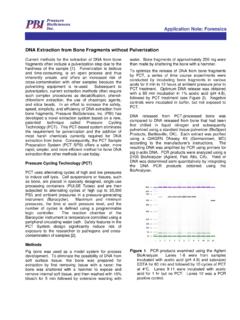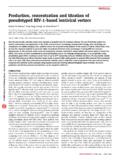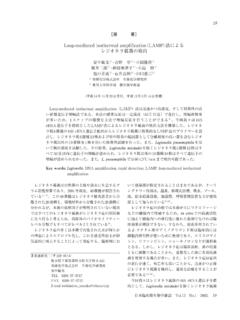Transcription of Genetic Characterization of Eastern “Coyotes” in …
1 NORTHEASTERN NATURALIST201017(2):189 204 Genetic Characterization of Eastern Coyotes in Eastern MassachusettsJonathan G. Way1, Linda Rutledge2, Tyler Wheeldon2, and Bradley N. White2 Abstract - This study examined the Genetic nature and relatedness of Canis latrans (Coyotes) in Eastern Massachusetts ( , Eastern Coyotes). We characterized 67 ani-mals at the mitochondrial DNA control region, and 55 of those at 8 microsatellite loci. Structure analysis and factorial correspondence analysis of the microsatellite genotypes indicated that the Eastern Coyotes in Massachusetts clustered with other northeastern Canis populations and away from western Coyotes, C.
2 Lycaon ( Eastern Wolves), and C. lupus (Gray Wolves). They contained mitochondrial haplotypes from both western Coyotes and Eastern Wolves, consistent with their hybrid origin from these two spe-cies. There was no evidence of either C. lupus familiaris (Domestic Dog) or Gray Wolf mitochondrial DNA in the animals. These results indicate that the Eastern coyote should more appropriately be termed Coywolf to refl ect their hybrid (C. latrans x lycaon) origin. Genetic data were also used to assess parental and kinship relationships, and con-fi rmed that family units typically contain an unrelated breeding pair and their offspring.
3 Lastly, a synthesis of knowledge of the Eastern coyote as well as implications for Wolf recovery in the northeast US is Canis latrans Say (Coyotes) living in northeastern North America ( , Eastern Coyotes) have been an enigma to both scientists and laypeople for many years (Parker 1995). This wild canid started to appear in northern New England and New York in the 1930s and 1940s and currently inhabits all of the northeastern United States and southeastern Canada, ranging from wilderness to urban areas (Fener et al. 2005, Parker 1995).
4 The animals are often described as a big version of the western coyote or a small Wolf, and many northern New Englanders still call them coy-dogs (Way 2007), yet there remains speculation regarding its origins (Wilson et al. 2009). While the Eastern coyote has been confi rmed as the largest version of the species (Gompper 2002, Lawrence and Bossert 1969, Silver and Silver 1969, Way 2007, Way and Proietto 2005), the animal s large body size has confused its taxonomy ( , the var. indicates a variation of coyote ) since it was fi rst described by Lawrence and Bossert (1969) and Silver and Silver (1969).
5 Hypotheses as to why Eastern Coyotes are bigger include response to enhanced food supply or larger prey (Thurber and Peterson 1991), Genetic ad-aptation to prey, mainly Odocoileus virginianus Boddaert (White-tailed Deer) (Larivi re and Cr te 1993), or their being coyote -dog hybrids (Mengel 1971). 1 Eastern coyote Research, 89 Ebenezer Road, Osterville, MA 02655. 2 Natural Resources DNA Profi ling and Forensic Centre, Environmental and Life Sciences Graduate Program, Trent University, Peterborough, ON L8S 4K1, Canada.
6 *Corre-sponding author - NaturalistVol. 17, No. 2190 Most of the data reject these hypotheses since medium-sized food ( , mice and rabbits) and deer are abundant throughout the United States (US) (dis-cussed in Way 2007), and coy-dogs reproduce in fall and give birth in winter instead of mating in winter and giving birth in early spring as wild canids do (Mengel 1971, Way et al. 2001). The asymmetry of coy-dog versus wild canid ( , Eastern coyote ) reproduction cycles appears to be an effective barrier preventing introgression of dog genes into wild canid populations in north- Eastern North America despite it occurring historically in the southeast US ( , Adams et al.)
7 2003a) this difference is likely due to harsh winters in the north, which prevent coy-dogs from surviving when born in mid-winter. Canis lycaon Schreber ( Eastern Wolves) in central Ontario, Canada, are genetically similar to and probably the same species as C. rufus Audubon and Bachman (Red Wolf) (Kyle et al. 2006, Wilson et al. 2000). The conspecifi c nature of Eastern and Red Wolves is supported by an accumulation of Genetic evidence ( , Kyle et al. 2006, 2008; Wilson et al. 2000, 2003, 2009). There-fore, to simplify, we hereafter use Eastern Wolves (C.
8 Lycaon) as an umbrella termninology that includes Red Wolves (C. rufus), although we note that Red Wolf samples from the southeastern US were not analyzed in this study. Evolutionarily, this small deer-eating wolf (Theberge and Theberge 2004) is more closely related to Coyotes than to C. lupus L. (Gray Wolf) (Hedrick et al. 2002, Wilson et al. 2000). The Eastern Wolf (not the Gray Wolf) is believed to be the original Canis species historically present in northeastern North America (Kyle et al. 2006, 2008; Wilson et al.
9 2000, 2003, 2009; although see Nowak 2002) before being extirpated by humans, and is likely the wolf (at a very small population size) that would have hybridized with western Coyotes during their eastward migration in the early 1900s (Parker 1995). The close evolutionary relationship of C. latrans and C. lycaon probably facilitated hybridization following landscape change, especially when wolf numbers were low (Grant and Grant 1997) in areas such as southern Ontario. In fact, the biggest perceived threat currently facing Eastern Wolves in the southeast US is hybridization with Coyotes colonizing the periphery of the North Carolina recovery area (Adams et al.
10 2003b). However, even small ( , re-colonizing) populations of Gray Wolves in the western US show no evidence of hybridiza-tion with western Coyotes ( , Pilgrim et al. 1998). The objectives of this study were to: (1) characterize the Genetic com-position of Massachusetts Eastern Coyotes in relation to other groups of Coyotes and wolves from the US and Canada, and (2) determine parentage and kinship within putative family units. We tested the hypotheses that: (1) Eastern Coyotes in Massachusetts were hybrids between Eastern Wolves and western Coyotes, and (2) these animals formed social groups (packs) consisting of unrelated breeding pairs and their Eastern Coyotes were sampled from Cape Cod (specifi cally, in and around the town of Barnstable) and within 20 km of Boston, MA (n = 67).






